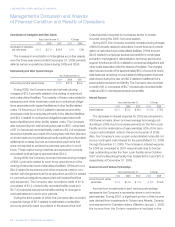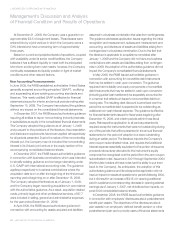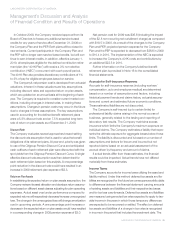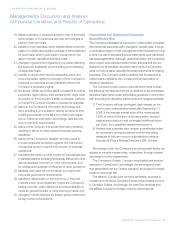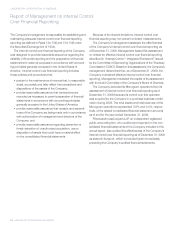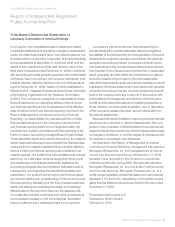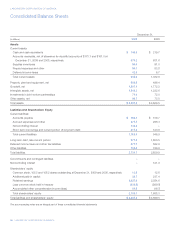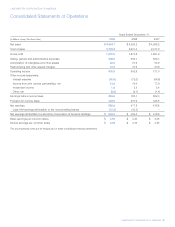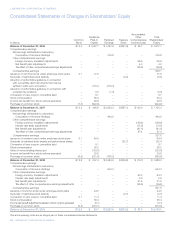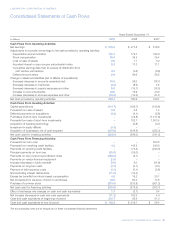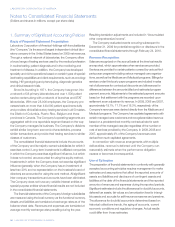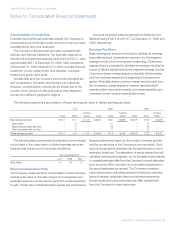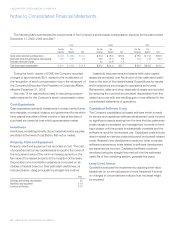LabCorp 2009 Annual Report Download - page 34
Download and view the complete annual report
Please find page 34 of the 2009 LabCorp annual report below. You can navigate through the pages in the report by either clicking on the pages listed below, or by using the keyword search tool below to find specific information within the annual report.32 LABORATORY CORPORATION OF AMERICA
LABORATORY CORPORATION OF AMERICA
Management’s Discussion and Analysis
of Financial Condition and Results of Operations
Company does not recognize a tax benefit, unless the Company
concludes that it is more likely than not that the benefit will be
sustained on audit by the taxing authority based solely on the
technical merits of the associated tax position. If the recognition
threshold is met, the Company recognizes a tax benefit measured
at the largest amount of the tax benefit that the Company believes
is greater than 50% likely to be realized. The Company records
interest and penalties in income tax expense.
Forward-Looking Statements
The Company has made in this report, and from time to time may
otherwise make in its public filings, press releases and discussions
by Company management, forward-looking statements concerning
the Company’s operations, performance and financial condition,
as well as its strategic objectives. Some of these forward-looking
statements can be identified by the use of forward-looking words
such as “believes”, “expects”, “may”, “will”, “should”, “seeks”,
“approximately”, “intends”, “plans”, “estimates”, or “anticipates”
or the negative of those words or other comparable terminology.
Such forward-looking statements are subject to various risks and
uncertainties and the Company claims the protection afforded by
the safe harbor for forward-looking statements contained in the
Private Securities Litigation Reform Act of 1995. Actual results
could differ materially from those currently anticipated due to a
number of factors in addition to those discussed elsewhere
herein and in the Company’s other public filings, press releases
and discussions with Company management, including:
1. changes in federal, state, local and third-party payer
regulations or policies (or in the interpretation of current
regulations), new insurance or payment systems, including
state or regional insurance cooperatives, new public
insurance programs or a single-payer system, affecting
governmental and third-party coverage or reimbursement
for clinical laboratory testing;
2. adverse results from investigations or audits of clinical
laboratories by the government, which may include
significant monetary damages, refunds and/or exclusion
from the Medicare and Medicaid programs;
3. loss or suspension of a license or imposition of a fine or
penalties under, or future changes in, or interpretations
of, the law or regulations of the Clinical Laboratory
Improvement Act of 1967, and the Clinical Laboratory
Improvement Amendments of 1988, or those of Medicare,
Medicaid, the False Claims Act or other federal, state or
local agencies;
4. failure to comply with the Federal Occupational Safety
and Health Administration requirements and the
Needlestick Safety and Prevention Act, which may result
in penalties and loss of licensure;
5. failure to comply with HIPAA, including changes to
federal and state privacy and security obligations and
changes to HIPAA, including those changes included
within HITECH, which could result in increased costs,
denial of claims and/or significant penalties;
6. failure to maintain the security of customer-related
information could damage the Company’s reputation
with customers, cause it to incur substantial additional
costs and become subject to litigation;
7. failure of the Company, third-party payers or physicians
to comply with Version 5010 Transactions by January 2012
or the ICD-10-CM Code Set issued by the Department
of Health and Human Services and effective for claims
submitted as of October 1, 2013;
8. increased competition, including competition from
companies that do not comply with existing laws or
regulations or otherwise disregard compliance standards
in the industry;
9. increased price competition, competitive bidding for
laboratory tests and/or changes or reductions to fee
schedules;
10. changes in payer mix, including an increase in capitated
managed-cost health care or the impact of a shift to
consumer-driven health plans;
11. failure to obtain and retain new customers and alliance
partners, or a reduction in tests ordered or specimens
submitted by existing customers;
12. failure to retain or attract managed care business as a
result of changes in business models, including new risk
based or network approaches, or other changes in strategy
or business models by managed care companies;
13. failure to effectively integrate and/or manage newly acquired
businesses and the cost related to such integration;
14. adverse results in litigation matters;
15. inability to attract and retain experienced and qualified
personnel;
16. failure to maintain the Company’s days sales outstanding
and/or bad debt expense levels;
17. decrease in the Company’s credit ratings by Standard &
Poor’s and/or Moody’s;
18. discontinuation or recalls of existing testing products;




